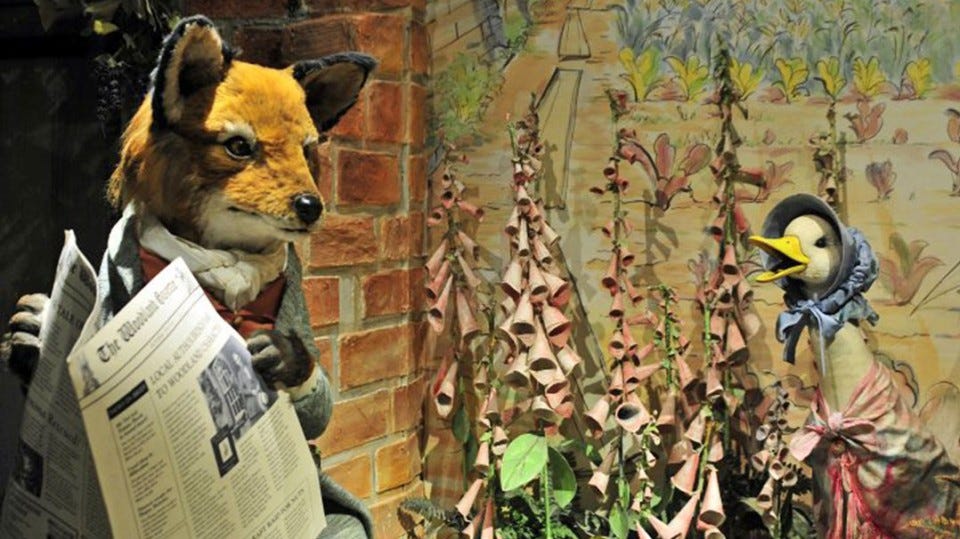A model scene from Beatrix Potter's 1906 children's story The Tale of Jemima Puddle-Duck. Credit: Susan Worsfold (Wildlife Online)
Animals have images. Owls and elephants are smart. Dogs are faithful. Cats go their own way. The fox, on the other hand, has often been perceived as a sneaky trickster, a sly devil.
That characterization is supported in literary efforts like Br’er Fox in the Uncle Remus Tales and the fox that’s after Jemima Puddle Duck in the Beatrix Potter tale.
In the world of Hanna-Barbera, the TV animation team that exerts such a dominant influence on our world, you had your animal heroes--Yogi Bear in Jellystone Park and a cowboy star, a horse by the name of Quick Draw McGraw. You also had Fibber Fox, always after Yakky Doodle, the obnoxious little duck protected by Chopper the relentless guard dog. Fibber was cast as a villain in the 1960s cartoon series but not a serious one. After all, how serious can you be when the inimitable Daws Butler is voicing your character while doing a Shelly Berman impersonation?
Last year’s animation hit, The Wild Robot, is the latest example of how the fox’s image is on the upswing. The fox in Robot resembles the fox character in Zootopia (2016), another animation hit: initially sneaky but soon heroic.
Wes Anderson recognized the power of the animal in his classic Fantastic Mr. Fox (2009) with its array of forthright foxes and the usual marvelous Anderson soundtrack (great use of the Beach Boys’ “Heroes and Villains”).
If you want to see another positive depiction of our four-legged friend, watch The Fox and the Bird, a 12-minute cartoon from Fred and Sam Guillaume from Switzerland made in 2018. This one might even make you cry. We should note that beavers don’t come off so well in this one. Usually portrayed as industrious little workers (Disney’s Lady and the Tramp comes to mind), these beavers are beasts.
Our fascination with the fox may have been exemplified by that one-hit wonder from 2013, “What Does the Fox Say?” The nonsensical song and video may have been inspired by the fact that the fox is known to produce a variety of sounds—from chirps to quick barks as well as loud screams during the mating season, according to Sam Wilson of the Nebraska Game and Parks Commission.
The real-life fox has something else going for it. They use the Earth’s magnetic field to hunt. National Geographic reported that Jaroslav Cerveny, a biologist in the Czech Republic, has done extensive research with foxes to substantiate that fact. “Foxes strongly prefer to jump in a northeasterly direction, around 20 degrees off from magnetic north. This fixed heading was important for their success as hunters,” the magazine noted.
So there we are, not only benefitting from a positive image campaign but, like migrating birds and bats, those sneaky foxes even know how to use the world’s magnetic field.






